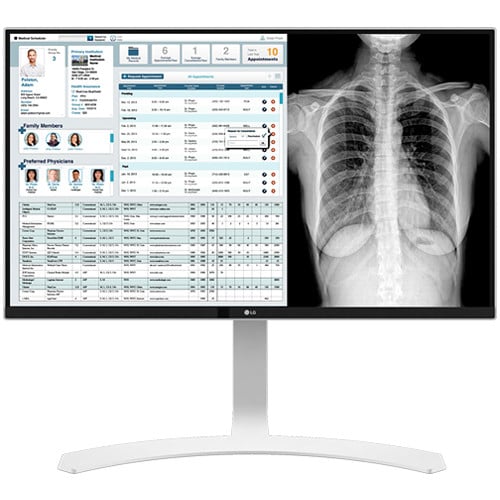
Click Here To View PSSAV’s Range Of LG Medical Monitors
As technology continues to advance, the demand for high-quality displays in various industries has also increased. In the medical field, displays play a crucial role in providing accurate and detailed information for healthcare professionals to make critical decisions. However, not all displays are created equal, and those designed for medical use have distinct features and specifications that set them apart from consumer or commercial displays.
We will explore the critical features and specifications that differentiate displays designed for the medical field from those for general consumer or commercial use.
One of the most significant differences between medical displays and consumer displays is the level of resolution and image quality. Medical displays are designed to provide high-resolution images with exceptional clarity and detail.
This is crucial in medical settings where accurate and precise visualization is necessary for diagnosis and treatment. Medical displays typically have a resolution of 2MP or higher, while consumer displays usually have a resolution of 1080p or lower.
Moreover, medical displays also have advanced image processing capabilities, such as noise reduction and contrast enhancement, to ensure that the images are of the highest quality. These features are essential in medical imaging, where even the slightest variation in image quality can affect the accuracy of diagnosis.
DICOM (Digital Imaging and Communications in Medicine) is the standard for handling, storing, printing, and transmitting medical imaging information. Medical displays are required to be DICOM compliant, which means they can accurately display images according to the DICOM standard. This is crucial in medical settings where images need to be consistent and standardized for accurate diagnosis and comparison.
On the other hand, consumer displays do not need to be DICOM compliant as they are not used for medical purposes. This is why medical displays are often more expensive than consumer displays, as they need to meet strict standards and undergo rigorous testing to ensure DICOM compliance.
In the medical field, color accuracy is of utmost importance. Medical displays are designed to provide accurate and consistent color representation, which is crucial in medical imaging. For instance, in radiology, the color of a tumor or lesion can indicate its type and severity.
Therefore, medical displays are calibrated to display colors accurately, ensuring that healthcare professionals can make accurate diagnoses.
On the other hand, consumer displays do not require such high levels of color accuracy and calibration. They are designed for general use, such as watching movies or browsing the internet, where color accuracy is not as critical.
Medical displays are also equipped with protective features that are not found in consumer displays. For instance, they have antimicrobial coatings to prevent the growth of bacteria and germs, making them suitable for use in sterile environments.
They also have a protective glass cover to prevent damage from accidental spills or scratches, which is essential in busy medical settings.
Moreover, medical displays are designed to be durable and long-lasting, as they need to withstand frequent use and cleaning. They are also designed to be energy-efficient, as they are often used for extended periods.
Medical displays need to comply with various medical standards, such as FDA (Food and Drug Administration) and IEC (International Electrotechnical Commission) standards. These standards ensure that the displays are safe to use in medical settings and do not interfere with other medical equipment.
Compliance with these standards is crucial in ensuring the safety and effectiveness of medical displays.
Medical displays have distinct features and specifications that set them apart from consumer or commercial displays. They are designed to provide high-resolution images with exceptional clarity and detail, comply with DICOM standards, and have advanced image processing capabilities.
They also have protective features, comply with medical standards, and are designed to be durable and energy-efficient. These critical features make medical displays an essential tool in the medical field, providing accurate and reliable information for healthcare professionals to make critical decisions.

Free ground shipping on orders all $99 and up.

We are an authorized dealer for every brand we sell.

Special pricing for preffered customers and dealers.

We are projector experts, with over 20 years of service.

From projectors to projection screens, digital signage to gaming equipment, PSSAV is Your number one source for audio visual equipment. over 200 top brands including Sony, Nec, Epson, Optoma, Benq, Chief, Dalite, Viewsonic, LG and more..
